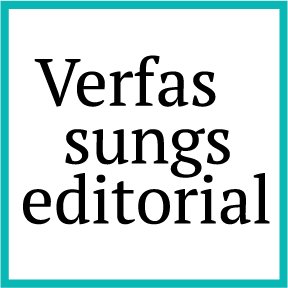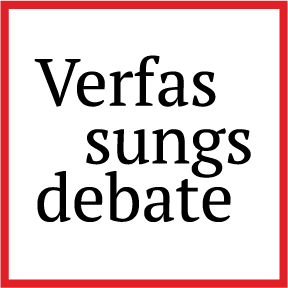The Questionable Concept of Protective Weapons
How Strasbourg Pushes Back Against Protest Restrictions in Germany
On 20 May 2025, the European Court of Human Rights (ECtHR) delivered a landmark judgment in the case of Russ v. Germany, holding that Germany’s imposition of a criminal fine on Benjamin Russ for wearing a makeshift visor during a protest violated his freedom of assembly. The Court condemned the undifferentiated approach of German courts. As discussed also in a recent post by Clemens Arzt, the Court thereby backed longstanding concerns in German legal scholarship regarding the constitutionality of criminal sanctions imposed on the carrying of defensive weapons. In addition, the ruling emphasises the role of the Court in safeguarding democratic participation across Europe.
The facts of the case
The case arose from a demonstration on 18 March 2015 in Frankfurt am Main, where the inauguration of the European Central Bank’s (ECB) new headquarters took place. Various organisations operating under the name Blockupy had called for mass demonstrations, including peaceful blockades. Russ joined a protest under the slogan “colourful, loud – but peaceful” (bunt, laut – aber friedlich). During the demonstration, he wore a transparent plastic sheeting with the imprint “smash capitalism” over his eyes, which was fixated behind his head by a rubber band (Russ v. Germany, §§ 5-6).
German courts later deemed this provisory shield a protective weapon, arguing that it could protect Russ from coercive police measures such as pepper spray. Since the mere carrying of such a protective weapon qualifies as a criminal offence under German assembly law, Russ was convicted in July 2016 and sanctioned with a criminal fine of 400 euros. His appeals were dismissed at all instances. He ultimately filed a constitutional complaint with the German Federal Constitutional Court (FCC), which declined to admit it for decision without providing any reasoning (Russ v. Germany, §§ 8-16). Only Russ’ last resort, the ECtHR, provided relief, holding that Germany had violated his right to freedom of assembly.
The right to freedom of assembly according to the European Convention on Human Rights
In his application, Russ claimed a violation of Art. 10 ECHR (freedom of expression) and Art. 11 ECHR (freedom of assembly and association), arguing that his conviction for wearing a makeshift visor during a protest infringed his freedom of assembly and that the Regional Court’s reliance on the slogan “smash capitalism” printed on the visor infringed his freedom of expression.
According to the ECtHR’s well-established case law, the applicability of Art. 10 ECHR or Art. 11 ECHR depends on the circumstances of the case (Guide on Art. 11 ECHR, § 8). For example, a one-person protest (Novikova and Others v. Russia, 2016, § 91) or slogans shouted through a window by a group of people (Yezhov and Others v. Russia, 2021, § 27) were examined under Art. 10 ECHR. In comparison, the conduct of demonstrators during an assembly, such as slowing down the traffic with a truck (Barraco v. France, 2009, § 39) or displaying a banner bearing a trade union logo and a strike slogan (Akarsubaşı and Alçiçek v. Turkey, 2018, §§ 31-33), fell under Art. 11 ECHR. In other cases, including the one at hand, the two rights are closely intertwined. The ECtHR thus examined Russ’s complaint under Art. 11 ECHR, read in light of Art. 10 ECHR (Russ v. Germany, §§ 33–35).
As only peaceful assemblies are protected by Art. 11 ECHR, an assembly loses its protection if its organisers intend to incite violence. Yet the organisers’ intentions must be distinguished from individual acts by participants and from causing actual harm (Russ v. Germany, § 36, see also previously Kudrevičius and Others v. Lithuania [GC], 2015, § 92). Accordingly, Germany argued that Art. 11 ECHR was not applicable due to the violent character of the broad protest on 18 March 2015 (Russ v. Germany, § 29). While violent demonstrations and burning barricades did in fact occur in Frankfurt that day in connection to the ECB inauguration, the government was unable to establish that the demonstration “colourful, loud – but peaceful” had violent aims. Nor did it demonstrate that its participants, or Russ himself, were involved in any violent acts.
The ECtHR therefore concluded that Art. 11 ECHR applied, and that Russ’s criminal conviction amounted to an interference with his right to peaceful assembly (Russ v. Germany, §§ 38-41). Since there was no indication that Russ had been convicted because of the imprint “smash capitalism”, the Court found no separate interference with the right to freedom of expression under Art. 10 ECHR (Russ v. Germany, §§ 35).
Protective weapons as abstract danger?
The topicality of the judgement lies in the question of whether the interference with Art. 11 ECHR can be justified: How wide is the State’s margin of appreciation when restricting the right to freedom of assembly, and was the criminal sanction imposed on Russ necessary in a democratic society according to Art. 11 (2) ECHR?
Section 17a(1) of the German Act on Public Assemblies and Processions (Gesetz über Versammlungen und Aufzüge) prohibits carrying so-called “protective weapons” (Schutzwaffen) during public outdoor assemblies. A violation can lead to criminal charges, punishable by up to one year of imprisonment or a criminal fine, according to Section 27(2) §1 (for an English translation of the provision cf Russ v. Germany, § 18).
Referring to materials from the legislative process, the District Court of Frankfurt am Main (constituting the first instance) defined protective weapons as “objects that are used for defence against attacks and are usually given this purpose at the time of manufacture”. The examples envisioned by the legislator include “protective shields, self-made armour or equipment for police and/or military use (e.g. steel helmets [and] NBC protective gas masks) or [items used in the] martial arts” (Russ v. Germany, § 10). The District Court reasoned that Russ’s transparent plastic visor, was designed to protect him from pepper spray possibly used by police forces and therefore qualified as a protective weapon. As the mere carrying of such an item satisfies the criminal offence under Section 27(2) §1, Russ was convicted by the Regional Court.
To justify an interference with Art. 11 ECHR, restrictions must be prescribed by law, pursue a legitimate aim as outlined in Art. 11 (2) ECHR, and be necessary in a democratic society (Russ v. Germany, § 42). The ECtHR accepted that the interference was based on clear legal provision and pursued legitimate aims – namely preventing disorder or crime and protecting the rights and freedom of others. A threat to these protective goods could arise, so the argument goes, from the “martial appearance” of protective weapons, which, as findings from the field of crowd psychology suggest, signals “a clear readiness to use violence” and may “stimulate aggression in the crowd” (Russ v. Germany, § 42, the Court citing the documents from the legislative process, cf. § 19).
In the following step, however, the Court scrutinised whether the interference was truly necessary in a democratic society. Reaffirming that freedom of assembly is a cornerstone of democracy, the Court stressed that any restriction must be interpreted narrowly. While States enjoy a certain margin of appreciation in restricting assemblies, this margin is subject to European oversight (Russ v. Germany, § 49). This review by the ECtHR is not limited to a mere assessment whether “the State exercised its discretion reasonably, carefully and in good faith”. Instead, the ECtHR engages in an in-depth examination of the justification for the interference (Russ v. Germany, § 50). It considers in particular “whether [the measure] was proportionate to that aim and whether the reasons adduced by the national authorities to justify it were ‘relevant and sufficient’” (Russ v. Germany, § 50).
A key factor in the assessment whether the measure was necessary in a democratic society was the nature and severity of the sanction. Section 27(2) §1 German Assemblies and Processions Act allows for criminal sanctions of up to one year of imprisonment. Even though Russ was ultimately fined 400 euros – a relatively mild punishment – criminal sanctions, demand special justification. This is particularly true, the Court emphasised, where the “protective weapon” had a very simple construction, like Russ’ makeshift visor (Russ v. Germany, §§ 51-53). Although section 17a(3) German Assemblies and Processions Act allows authorities to grant exemptions, this option was not considered. Nor did the police ask Russ to remove the visor (Russ v. Germany, §§ 54-55). The ECtHR also noted that the sanction was criminal rather than administrative in nature. Criminal courts, it held, must take into account the right to freedom of assembly and carefully balance it against the legitimate aim of preventing disorder and crime. By citing Navalnyy v. Russia [GC], § 152, the Court also pointed to the risk of chilling effects on protest participation when criminal sanctions are imposed on demonstrators (Russ v. Germany, § 56).
Through these findings the ECtHR addressed the nature of Section 27(2) §1 German Assemblies and Processions Act – a provision that penalises the abstract danger of an act irrespective of actual harm (abstraktes Gefährdungsdelikt, Kretschmer NStZ 2015, 505). Given the important role of assembly rights in a democracy, the ECtHR concluded that it is not sufficient for German national courts to establish that an object, especially when it is of very simple construction, was intended to and capable of providing protection from coercive police measures. Instead, they must engage in a balancing exercise including the accused’s freedom of assembly, the legitimate aim of the restriction, and the concrete circumstance of the case.
Strasbourg’s reminder: Human rights law demands respect
Section 27(2) §1 German Assemblies and Processions Act that was now under scrutiny by the ECtHR has also been criticised before by German academics. The criminal offence of carrying protective weapons is predominantly seen critically and numerous voices have questioned its compatibility with fundamental rights and called for a constitutional interpretation 1). The ECtHR has now powerfully backed these voices and given them a strong argument.
Yet the ruling does more than support an academic critique: it reasserts the role of the Court in ensuring that human rights remain practical and effective (Chassagnou and Others v. France [GC], § 100). With democratic freedoms increasingly under pressure, the ECtHR reminds national courts and lawmakers that freedom of assembly is a cornerstone for a democratic society. This is a moment for the German legislator to consider revising the respective provision to ensure its constitutionality. Until then, the judgement will remain a bedrock for the right to freedom of assembly in Germany.
References
| ↑1 | Tölle, in: MüKo StGB 2022, § 27 VersG, N 17; Wache, in: Erbs, Kohlhaas, Strafrecht Nebengesetze 2025, VersG § 27, N 11, Dürig-Friedl, in: Dürig-Friedl, Enders, Versammlungsrecht 2022, § 27 VersG, N 9; rather sceptical in this regard Gerhard, in: BeckOK StGB 2025, § 27 VersG, N 49, 54 and Brinsa, in: Ridder, Breitbach, Deiseroth, Versammlungsrecht 2020, § 27 VersG, N 59-61 |
|---|



